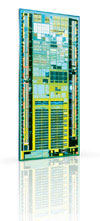Intel's Atom Architecture: The Journey Begins
by Anand Lal Shimpi on April 2, 2008 12:05 AM EST- Posted in
- CPUs
Intel Aims at the Mainstream
 We can easily make arguments for faster processors in most desktops and notebooks, but we're on the verge of computing being far more ubiquitous than that. Our desktops and notebooks have gotten so fast that we demand similar functionality and responsiveness from all electronic devices we use on a regular basis. The most frustrating until recently was the smartphone; smartphones have become more complex in the types of tasks we require of them, yet their interfaces have hardly given us the PC-experience we're used to. Apple attempted to change this with the iPhone but there's still much room for improvement. We've seen the same sorts of problems on more conventional consumer electronics. Blu-ray players that cost as much as PCs yet take longer to boot up and are beyond sluggish when interacting with menus. We can run Half Life 2 at 200 fps but we can't make the UI on a TV respond quickly to button presses on a remote control?
We can easily make arguments for faster processors in most desktops and notebooks, but we're on the verge of computing being far more ubiquitous than that. Our desktops and notebooks have gotten so fast that we demand similar functionality and responsiveness from all electronic devices we use on a regular basis. The most frustrating until recently was the smartphone; smartphones have become more complex in the types of tasks we require of them, yet their interfaces have hardly given us the PC-experience we're used to. Apple attempted to change this with the iPhone but there's still much room for improvement. We've seen the same sorts of problems on more conventional consumer electronics. Blu-ray players that cost as much as PCs yet take longer to boot up and are beyond sluggish when interacting with menus. We can run Half Life 2 at 200 fps but we can't make the UI on a TV respond quickly to button presses on a remote control?
The problem is that most of the CE industry is quite commoditized and we're quickly headed for a world where LCDs become cheap enough that it makes sense to have multiple surfaces in a room that can act as displays. There's no room for a powerful CPU that costs hundreds of dollars in TVs, Blu-ray players or even simpler devices like portable GPS units.
The processing power required by the interface on a television, the software stack on a GPS, or even the non-decoding components of a Blu-ray player can easily be handled by even the cheapest desktop processors. The question isn't "can we" make these devices faster, it's what's the bare minimum CPU we need to make them faster.
Such a CPU would have to be low power, low cost but without sacrificing performance.
You could argue that the sorts of applications we're talking about can easily be satisfied by something as slow as a Pentium III, or maybe even the first Pentium M perhaps? And this is where Moore's law comes into play.
A few years ago, the Pentium III, Pentium 4 and Pentium M were all just as expensive to make as today's Core 2 Duo processors. These days their transistor counts pale in comparison to the 400 - 800 million we're talking about on desktop CPUs. Within 2 years we'll be at over 1 billion transistors on a desktop CPU that costs less to manufacture than the original Pentium processor. But if we looked at it from another angle - is it possible to build a microprocessor that offers the performance of the original Pentium M but make it cheap enough to use in commoditized consumer electronics and make it low power enough to be run without a heatsink?










46 Comments
View All Comments
lopri - Thursday, April 3, 2008 - link
This article is as much propagana-ish as it is technical. Did you read the last page of the article?clnee55 - Friday, April 4, 2008 - link
Since Anand wrote this article. I let him answer your accusationGulWestfale - Wednesday, April 2, 2008 - link
i believe that the graphics core in the chipset is a powerVR gen5 derivative; intel already uses some of their tech in its existing mainboards and wikipedia states that intel has licensed gen5 tech for one of its chipsets, the GMA500 (which is the same as poulsbo?) gen5 is also DX10-capable, which matches the info in your article.http://en.wikipedia.org/wiki/PowerVR#Series_5_.28S...">http://en.wikipedia.org/wiki/PowerVR#Series_5_.28S...
yyrkoon - Wednesday, April 2, 2008 - link
and wikipedia has been known to be wrong . . . a lot lately it seems.My point here *is*, I would probably trust anandtech more than wikipedia now days, as it seems any Joe can put up a 'reference' without citation.
jones377 - Wednesday, April 2, 2008 - link
Following the references link from the Wiki article...http://www.imgtec.com/News/Release/index.asp?NewsI...">http://www.imgtec.com/News/Release/index.asp?NewsI...
Poulsbo uses a PowerVR 3D core
Anand Lal Shimpi - Wednesday, April 2, 2008 - link
Yep, you guys are correct, I wasn't aware that it was public yet :) I've updated the article.Take care,
Anand